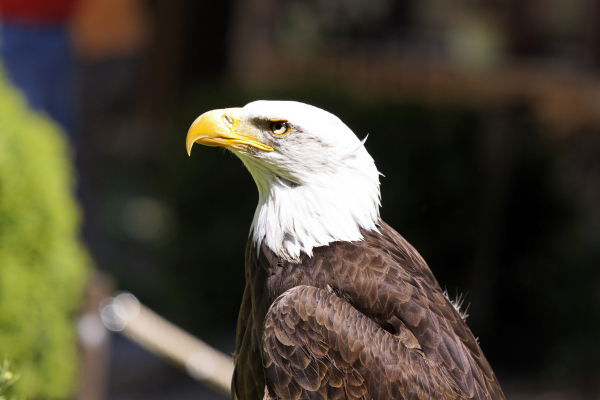
Written By: Sahil
The Bald Eagle(Haliaeetus leucocephalus)is a bird of prey native to North America. It is easily recognizable due to its white head and the yellow beak. The bald eagle is not bald. The “ Bald ” is a deviation of “ balde ”, an Old English word meaning white. The eagle was named for its white feathers instead of a lack of feathers. It is a sea eagle, and its preferred prey is fish, although it occasionally preys upon small mammals. The Bald Eagle is the national emblem of United States since 1782.
Physical Description:
The Bald Eagle is a majestic bird of prey. The plumage of adults is dark brown with a white head and yellow beak. They have moderately long tails. Both male and female Bald Eagles have the same colored plumage. On average, the females are 25% larger than the males. Adults are 71-96 cm(2’4″-3’1.8″) in length with a wingspan of 168-244 cm(5’6.1″-8’0.1″). They weigh around 3-6.3 kg(6.61-13.9 lbs.). Their feet are bare and yellow in color, and equipped with powerful talons. Juveniles are completely brown except for the yellow feet. The plumage of the immature is brown, speckled with white until the fifth (rarely fourth, very rarely third) year, when it reaches sexual maturity.
Habitat and Range:
Bald Eagles prefers habitats near seacoasts, rivers, large lakes, and other large bodies of open water with an abundance of fish. Studies have shown a preference for bodies of water with a circumference greater than 11 kilometers (7 miles), and lakes with an area greater than 10 km² (3.9 square miles) are optimal for breeding Bald Eagles. The Bald Eagle is extremely sensitive to human activity and occurs most commonly in areas free of human disturbance. It chooses sites more than 1.2 kilometers (0.75 miles) from low-density human disturbance and more than 1.8 kilometers (1.2 miles) from medium- to high-density human disturbance.
It is the only sea eagle native to only north America. Its native range covers most of North America, including most of Canada, all of the continental United States and northern Mexico.
Diet:
The Bald Eagle is an opportunistic bird of prey, with the capacity to eat a variety of prey. Its preferred prey is fish. Bald Eagles pluck fish out of the water with their talons, and sometimes they follow seabirds as a means of locating fish. Bald Eagles also rob ospreys of their fish. Besides live fish, Bald Eagles also prey on other birds, small mammals, snakes, turtles, and crabs, and they readily eat carrion.
Reproduction:
Bald Eagles reach sexual maturity at 4-5 years of age. The average lifespan of Bald Eagles in the wild is around 20 years. When they are ready to breed, they often return to the area where they were born. They are believed to mate for life. However, if one member of a pair dies or disappears, the survivor will choose a new mate. A pair constructs an enormous stick nest, one of the bird-world’s biggest, high above the ground.
Immature Bald Eagles are dark, and until they are about five years old, they lack the distinctive white markings that make their parents so easy to identify. Young eagles roam great distances. Florida birds have been spotted in Michigan, and California eagles have traveled all the way to Alaska. The young hatchlings fledge at the age of 8-14 weeks. During this time, they stay close to the nest.
Conservation Status:
The Bald Eagle is the national symbol of the United States of America, so when it became threatened with extinction in the 1960s due to pesticide use, habitat loss, and other problems created by humans, people took notice. For years the Bald Eagle was listed as endangered under the Endangered Species Act. Now the number of Bald Eagles has increased so much that in June 1994, the U.S. Fish and Wildlife Service proposed that they be downgraded from endangered status to the less urgent status of threatened in all but three of the lower 48 states. The success of the Bald Eagle is a tribute to the Endangered Species Act and is an incentive for increased awareness and conservation everywhere.
Sahil is a freelance writer who does not necessarily share the opinions expressed on BrantaMedia.com.
